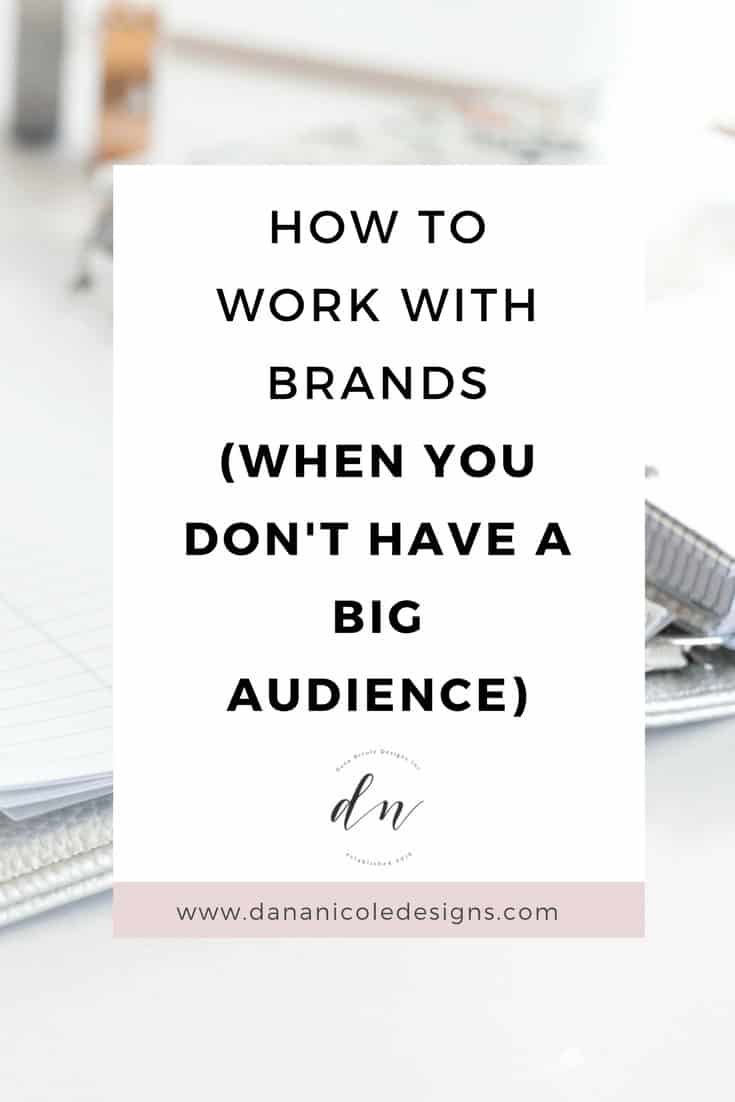Last Updated on

“How do I work with brands as a new blogger?”
It’s a question I see all the time in Facebook groups for bloggers and small businesses. And for good reason – if you’re starting up a blog it makes sense to want to know how you can work with brands! Working with other brands can be a source of income, it can build your exposure and help your blog overall.
But when you’re first starting out, you may think your blog is too small, or that you need to spend more time growing your Instagram before you will be able to secure any collaborations.
But I’ve got good news – you don’t need a huge following to work with brands.
In fact, micro-influencers are a huge trend for marketing in 2018.
So, let’s discuss what you can do to work with brands as a small blogger!
Sell Your Strengths
If you don’t have tons of followers or page views, you aren’t going to be able to use “exposure” as a benefit of working with you, because you won’t be able to deliver on that (and that’s totally ok)!
Instead, find something that you can offer the company on the other end. For example, are you a photographer who is capable of taking beautiful photos?
Or perhaps you are a talented writer who is able to captivate any audience you write for.
When pitching brands to work with, tell them what your strengths are, and why they would benefit from partnering with you!
Focus On Your Growth
One advantage smaller bloggers have is their growth is often much faster. For example, if you were only at 100 Instagram followers last month, and within a month gained 400 (and now have 500), that is a 400% increase in followers.
If you have 20,000 followers and gain 400 in a month, that is only a 2% increase. So while a bigger account is able to showcase their follower count, smaller accounts should instead showcase their growth.
To figure out your monthly growth, take your current follower count and subtract it from what your follower amount was a month ago (a.k.a your original follower account). This will give you the increased amount. Now, take the increased amount and divide that by your original follower account and times by 100.
This will give you your growth rate for the current month!
Now, when you mention your follower count to potential brands, highlight your growth rate.
For example: “I have a dedicated and growing following of 600 followers on Instagram. In the last month, I have grown my Instagram following by 150% and show no signs of slowing down.”
Doing this tells companies that you are actively working to grow your own brand, and will help you secure work with brands!
Know Your Audience
I’m going to tell you a story about the importance of knowing your audience. Once a blogger reached out to me and was wondering if I could do some free design work for her (and by some, I mean $1,500 worth of free design work) in exchange for a mention on her Instagram story.
When I read the message I thought to myself, “first of all, this person doesn’t value design too much but secondly, she must have a huge and dedicated following to value her Instagram stories at $1,500 a pop”.
So I went to go check her page out and she had a little over 10,000 followers (and was not even in my niche).
Her followers were not the types of people who would care to know about my services and her shout-out would not be worth anything for me.
I can only imagine that large companies must get inundated with similar requests from bloggers looking for free product or paid sponsorship who aren’t even in the same niche.
If you are a smaller blogger or business and you are looking to work with brands, you must be able to speak about your audience and how they would love to know more about the brand you hope to work with.
If you don’t know who your audience is, you should first make sure you have a professional Instagram account-type (such as a business account or a creator account.
There are three different types of Instagram accounts: personal, business and creator.
As an influencer, the creator account was created with you in mind. With a creator account, you will be able to view audience demographics, stats and other important information to help you land brand partnerships.
You can also determine some psychographic information on your audience based upon what you post, and what gets the most likes. Psychographic information includes your audiences’ likes, values, opinions, interests and lifestyle. It goes way deeper than the demographic information, which is primarily age, gender, wage, education level, income level etc.
You can try and figure out the psychographics of your audience by looking at what types of posts resonate with them. For example, do your posts on fashion tend to get a lot of likes? Then chances are your audience is interested in fashion! It’s very beneficial to try and understand what your audience likes!
Another way to find that out is to simply Google. I know that my audience is entrepreneurial millennial women located primarily in the United States. Knowing that, I can start Googling my audience to find out some more psychographic information about them!
You will want to let the brand know that your audience is very similar to their audience and describe the similarities.
Convey The Value/Benefit of Working With You
If you want to work with brands, you are going to want to think like a big brand. Time to put on your marketing hat and get into the mindset of a marketer and ask yourself WITFM (otherwise known as “what’s in it for me?”).
Brands aren’t looking to work with bloggers for the sake of working with bloggers.
They want to work with them because it’s an easy way to get in front of incredibly targeted followers (as opposed to traditional avenues of marketing)!
When you pitch a company, it’s great to talk about how much you love their product/services, what you can do for them, and how much your audience is growing, but you also want to make sure you tell the brand why working with you will be incredibly valuable for them.
We’ve already touched on this above by selling your strengths and talking about how your audiences are both very similar, so try to think of other reasons why a brand might benefit from working with you.
Focus On Specific Metrics
When pitching companies in hopes of working with them, they are going to want to know certain metrics about your blog and your followings. If you are able to provide these metrics in your initial pitch, you will be seen as informed and professional. Even if these metrics aren’t super high, you’ll likely still get asked about them.
You will want to provide this information on your media kit.
The metrics you can focus on (if they apply to you) are:
- your growth rate
- your social media followings
- the number of subscribers you have
- your social shares
- number of average comments on each blog post
- Instagram metrics (impressions, reach, likes, comments)
When trying to work with brands, bloggers often only focus on the big picture metrics such as follower count and blog traffic, but often forget about other powerful metrics that tell an even better story!
Growth Rate
We talked about why it is important to highlight your growth rate above. This metric shows that although you are smaller, you could potentially be big within the next year which would still be beneficial for a collaboration.
Social Media Followings
If you don’t have a huge audience on each social platform individually, you can consider offering a company more than just an Instagram post. Instead, offer to write a blog post, a post to Instagram, and then share it to your Facebook page, Twitter and Pinterest (or whatever other social media platforms you are on) in order to increase the reach!
Number Of Subscribers You Have
If you have an email list or a list of subscribers, don’t forget to let brands know about this. Never offer those emails up, but having an email list serves as great negotiating leverage. An email list is a great way to get in front of your audience without having to worry about an algorithm, and brands know how valuable an email list is.
In this case, you can offer to include your write-up in your next email newsletter.
Social Shares
If you have a share tracker on your blog (like the one I have on this blog) you will be able to gather some important data about how far your reach goes on social media.

I use the Cresta Social Share Counter plugin as it doesn’t slow down my website (I’ve found a lot of popular social shares are terrible for website speed) and it also collects past information. Some social share plugins only collect information from the day you install them, but this one shows past shares as well!
Number of Comments Per Blog
If you have a blog that generates comments, be sure to share this as it showcases a loyal audience! An easy way to find the average number of comments per blog post is to just add up all your comments and divide by the number of blog posts.
Instagram Metrics
Get yourself started with an Instagram business account and you will have access to metrics such as reach, impressions and the demographics of your followers.
Refer To Past Collaborations
This point only applies to those who have landed a collaboration in the past, but if you are looking to work with brands and you’ve already managed to work with one or two in the past, don’t forget to mention those in your media kit!
You’ll want to touch on the work you did for the company, as well as what concrete results the company saw through partnering with you. For example, did you bring in new traffic to their website? Did they see an increase in activity on their Instagram account during your partnership?
Some of these stats will be hard to determine, but after working with a company, follow up with them shortly after and ask if they are able to provide you with any concrete results that they can tie directly to your collaboration.
If you are a small blogger looking to work with brands, don’t get discouraged! Everyone starts somewhere and brands are always looking to work with smaller bloggers as it’s more affordable and economical, and can often result in a hyper-targeted audience!
If you enjoyed this blog post I’d love a social share! Use the buttons along the side to pass the knowledge around!
This article may include affiliate links. As an Amazon Associate I earn from qualifying purchases.

Dana Nicole is an award-winning freelance writer for MarTech/SaaS who was rated one of the best SaaS writers by Software World. She specializes in writing engaging content that ranks high in search engines and has been featured in publications like Semrush, ConvertKit, and Hotjar.
Dana holds a Bachelor’s degree in Business Administration and has over 15 years of experience working alongside national brands in their marketing departments.
When Dana’s not working, you can find her dancing en pointe, cooking up new recipes, and exploring the great outdoors with her two big dogs.


Really appreciate this detailed post! I used it to make my media kit and land my firs brand collaboration! Thanks so much.
Love that, Madison!! Congrats on the brand deal and here’s to many more to come 🙂
Thanks for this. A lot of experts I know don’t mention half these things.